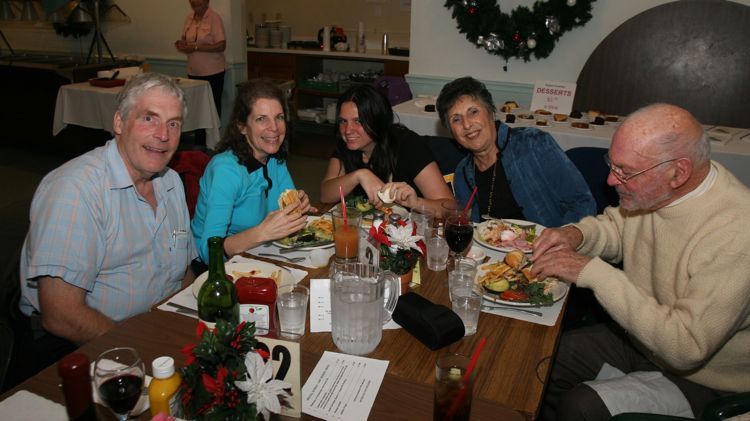Jam Session Are Always Fun
Time to Jam at the Santa Ana Elks! Wow, what a collection we had tonight! Great music and amazing vocalists! The entire evening was super!
We got there a little early to save two tables and when all was done and said, we had three tables with extra chairs pulled in!
Did you know? - A jam session is a musical act where musicians play (i.e. "jam") by improvising without extensive preparation or predefined arrangements.
Jam sessions are often used to develop new material, find suitable arrangements, or simply as a social gathering and communal practice session. Jam sessions may be based upon existing songs or forms, may be loosely based on an agreed chord progression or chart suggested by one participant, or may be wholly improvisational. Jam sessions can range from very loose gatherings of amateurs to sophisticated improvised recording sessions intended to be edited and released to the public.


We were the first ones to arrive

It filled up fast

Time to coordinate plans

George and Ludy joined our group... A very nice

The group has settled in for a great evening

We have bongos this evening
Did you know? - ongo or bongos are a Cuban percussion instrument consisting of a pair of single-headed, open-ended drums attached to each other. The drums are of different size: the larger drum is called in Spanish the hembra (female) and the smaller the macho (male). It is most often played by hand and is especially associated in Cuban music with a steady patter or ostinato of eighth-notes known as the martillo or "hammer". They are membranophones, or instruments that create sound by a vibration against a stretched membrane.
The name may have evolved from the Abakua drum trio 'Bonko' and its lead drum 'Bonko Emmiwewos'. These drums are still a fundamental part of the Abakua Religion in Cuba. If joined with a wooden peck in the middle, such drums would look much like the bongos we know today.

Herb and Irenes family join the parade!
Melissa swing dances at school

Who Wasn't Here?

Gladys and Vance... Vance is attempting to yodle (we think)
Did you know? - Yodeling (or yodelling, jodeling) is a form of singing that involves singing an extended note which rapidly and repeatedly changes in pitch from the vocal or chest register (or "chest voice") to the falsetto/head register; making a high-low-high-low sound. This vocal technique is used in many cultures throughout the world.
In Alpine folk music, it was developed in the Central Alps as a method of communication between alpine mountaineers or between alpine villages, with this non-musical multi-pitched "yelling" later becoming part of the region's traditional lore and musical expression.
In Persian classical music, singers frequently use tahrir, a yodeling technique that oscillates on neighbor tones.
In Georgian traditional music, yodelling takes the form of krimanchuli technique, and is used as a top part in three/four part polyphony.
In Central Africa, Pygmy singers use yodels within their elaborate polyphonic singing, and the Shona people of Zimbabwe sometimes yodel while playing the mbira[1]. Yodeling is often used in American bluegrass and country music.
According to the Oxford English Dictionary the word yodel is derived from a German word jodeln (originally Austro-Bavarian language) meaning "to utter the syllable jo".

Nancy and Vince were a pleasant surprise

Del and Vicky

Marcia and Leon

Ed and Cathy Roberts

Bob and Sue

Sandy and Bob with Sue

Sandy and Bob discussing sports



George and Ludy

Roy checking it out!

Jan visits with Ken and Amy White
Did you know? - A visiting card, also known as a calling card, is a small paper card with one's name printed on it. They first appeared in China in the 15th century, and in Europe in the 17th century. The footmen of aristocrats and of royalty would deliver these first European visiting cards to the servants of their prospective hosts solemnly introducing the arrival of their owners.
Visiting cards became an indispensable tool of etiquette, with sophisticated rules governing their use. The essential convention was that one person would not expect to see another person in her own home (unless invited or introduced) without first leaving his visiting card for the person at her home.
Upon leaving the card, he would not expect to be admitted at first, but might receive a card at his own home in response. This would serve as a signal that a personal visit and meeting at home would not be unwelcome. On the other hand, if no card were forthcoming in return, or if a card were sent in an envelope, a personal visit was thereby discouraged.
As an adoption from French and English etiquette, visiting cards became common amongst the aristocracy of Europe, and also in the United States. The whole procedure depended upon there being servants to open the door and receive the cards and it was, therefore, confined to the social classes which employed servants.

Sue watches the cameraman carefully

Sue
and Paul Liles in matching colors

Did you know? - Red is any of a number of similar colors evoked by light consisting predominantly of the longest wavelengths of light discernible by the human eye, in the wavelength range of roughly 630–740 nm. Longer wavelengths than this are called infrared (below red), and cannot be seen by the naked human eye. Red is used as one of the additive primary colors of light, complementary to cyan, in RGB color systems. Red is also one of the subtractive primary colors of RYB color space but not CMYK color space.
The word red comes from the Old English rēad. Further back, the word can be traced to the Proto-Germanic rauthaz and the Proto-Indo European root reudh-. In Sanskrit, the word rudhira means red or blood. In the English language, the word red is associated with the color of blood, certain flowers (e.g. roses), and ripe fruits (e.g. apples, cherries). Fire is also strongly connected, as is the sun and the sky at sunset. Healthy light-skinned people are sometimes said to have a "ruddy" complexion (as opposed to appearing pale). After the rise of socialism in the mid-19th century, red was used to describe revolutionary movements.

Table One

Table Two
The Lodge Was Decorated This Morning

Did you know? - According to Christian lore, the Christmas tree is associated with St Boniface and the German town of Geismar. Sometime in St Boniface's lifetime (c. 672-754) he cut down the tree of Thor in order to disprove the legitimacy of the Norse gods to the local German tribe. St. Boniface saw a fir tree growing in the roots of the old oak. Taking this as a sign of the Christian faith, he said "...let Christ be at the center of your households..." using the fir tree as a symbol of Christianity.
he tradition of the Christmas tree as it is today known is fairly young. It was established by Martin Luther as a Protestant counterpart to the Catholic Nativity scene. Luther established the Christmas tree as a symbol of the Tree of Life in the Garden of Eden.
Time To Hit The Floor

Sandy and Bob headed to the dance floor

Jan and Vance warm up

Ludy and George with Herb and Irene

Looking good!

OMG! What does Del have in his hands?
Did you know? - Teetotalism (sometimes tee-totalism) refers to either the practice of or the promotion of complete abstinence from alcoholic beverages. A person who practices (and possibly advocates) teetotalism is called a teetotaler or teetotaller (plural teetotalers or teetotalli) or is simply said to be teetotal. The teetotalism movement was first started in Preston, England in the early 19th century.
Some common reasons for choosing teetotalism are religious, health, family, philosophical, fear of gastric/epi-gastric and/or social reasons, and, sometimes, as simply a matter of taste preference. When at drinking establishments, they either abstain from drinking or consume non-alcoholic beverages such as tea, coffee, water, juice, soft drinks and mocktails.
Contemporary and colloquial usage has somewhat expanded teetotalism to include strict abstinence from most "recreational" intoxicants (legal and illegal). Most teetotaler organizations also demand from their members that they do not promote or produce alcoholic intoxicants.

"I can hold it"

Oh oh! Dels head is looking a little fuzzy after JUST HOLDING the wine

He is OK now... He has a firm grasp on the situation
Did you know? - The ISO has standardized a series of glasses for wine tasting. They are stemmed with elongated tapered bowls, with capacities of 120 (for sherry), 210, 300, or 410 millilitres. ISO 3591:1977

The "Wine Fairy" stops by the table
Did you know? - The word fairy derives from Middle English faierie (also fayerye, feirie, fairie), a direct borrowing from Old French faerie (Modern French féerie) meaning the land, realm, or characteristic activity (i.e. enchantment) of the legendary people of folklore and romance called (in Old French) faie or fee (Modern French fée). This derived ultimately from Late Latin fata (one of the personified Fates, hence a guardian or tutelary spirit, hence a spirit in general); cf. Italian fata, Spanish hada of the same origin.
Fata, although it became a feminine noun in the Romance languages, was originally the neuter plural ("the Fates") of fatum, past participle of the verb fari to speak, hence "thing spoken, decision, decree" or "prophetic declaration, prediction", hence "destiny, fate". It was used as the equivalent of the Greek Μοῖραι Moirai, the personified Fates who determined the course and ending of human life.
To the word faie was added the suffix -erie (Modern English -(e)ry), used to express either a place where something is found (fishery, heronry, nunnery) or a trade or typical activity engaged in by a person (cookery, midwifery, thievery). In later usage it generally applied to any kind of quality or activity associated with a particular sort of person, as in English knavery, roguery, witchery, wizardry.

Vicky has a plan

Vance is sneaking off to the dessert table
The Emblems Keep Us Fit With Plenty Of Calories


"Not a single calorie on this table... There are however, many doubles and triples!"

Band Leader and Vocalists plan the next song
Did you know? - The large calorie, kilogram calorie or food calorie (symbol: Cal) approximates the energy needed to increase the temperature of 1 kilogram of water by 1 °C. This is exactly 1000 small calories or about 4.2 kilojoules.

Ken and Bob in serious conversations

Beware, this group in a huddle... That can only mean 1,567,787,983,231 things
Did you know? - In sport and jam sesson dancing, a huddle is when a team gathers together, usually in a tight circle, to strategise, motivate or celebrate. It is a popular strategy for keeping opponents insulated from sensitive information, and acts as a form of insulation when the level of noise in the venue is such that normal on-field communication is difficult. Commonly the leader of the huddle is the team captain and it is the captain who will try and inspire his fellow team members to achieve success. Similarly after an event a huddle may take place to congratulate one another for the teams success, or to commiserate a defeat. The term "huddle" can be used as a verb as in "huddling up".